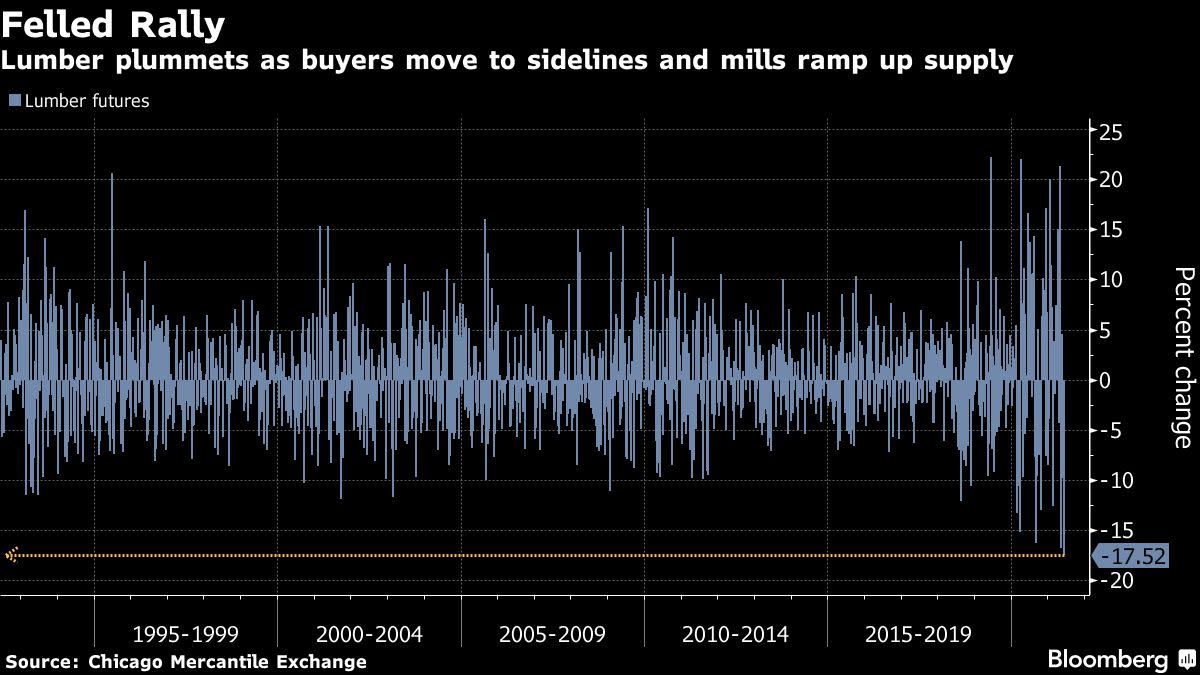Lumber Prices Post Biggest–Ever Weekly Drop With Buyers Balking

(Bloomberg) — Lumber futures posted their biggest-ever weekly loss, extending a tumble from all-time highs reached last month as sawmills ramp up output and buyers hold off on purchases.
Prices in Chicago fell 18% this week, the biggest decline for most-active futures in records going back to 1986. Lumber has has now dropped almost 40% from the record high reached on May 10.
Sawmills appear to be catching up with the rampant homebuilding demand in North America that fueled a months-long rally, bringing some relief to a market beset by supply shortages and price surges. Buyers are balking at still historically elevated prices and awaiting additional supplies, setting off a cascading sell-off, analysts said.
“Activity yesterday was brisk to start, turned lethargic and ended quite subdued,” William Giguere, who buys and sells eastern spruce with mills for Sherwood Lumber in Massachusetts, said in a note Friday. “There was plenty of lumber available from the mills and enough ambition to sell. Missing was the sense of urgency from buyers.”
Many buyers only purchased if necessary, generally staying on the sidelines, CIBC analyst Hamir Patel said Friday, citing an assessment from Random Lengths. The closely watched trade publication reported further declines in several wood products that trade on the cash market, and pointed to an abundance of mill offerings, Patel said.
U.S. lumber production has responded to the price rally by ramping up output by 5% over the past 12 months with another expected increase of 5%, or roughly 1 billion board feet, according to Domain Timber Advisors LLC, a subsidiary of Domain Capital Group, in Atlanta, Georgia.
Resolute Forest Products Inc. is spending $50 million to increase its lumber production, the company said Thursday. West Fraser Timber Co., the world’s biggest producer, said recently that it’s expanding capacity at five U.S. mills, while rival Canfor Corp. has said it will invest around $160 million in a new sawmill in Louisiana.
Above-Trend
Still, while lumber prices may finally be pulling back from stratospheric highs, don’t look for a return to pre-pandemic levels any time soon, according to BMO Capital Markets.
“‘Nosebleed’ prices won’t last, but strong demand, a limited supply response and a rising cost curve all point to above-trend prices for at least the next 12-24 months,” BMO analyst Mark Wilde said in a note.
Lumber futures slid 5.6% in Chicago to $1,059.20 per 1,000 board feet on Friday. Prior to the rally that started in mid-2020, lumber futures traded mostly within the range of $200 to $600 since 1992.
With strong U.S. home building expected to last for several years, lumber prices will likely remain above $500 per 1,000 board feet for the next five to eight years, said Scott Reaves, forest operations director at Domain Timber Advisors.
“We’re at a new normal,” Reaves said in a phone interview. “We’re going to see this sustained level of housing demand and a new normal for a pricing floor in lumber.”
More stories like this are available on bloomberg.com
Subscribe now to stay ahead with the most trusted business news source.
©2021 Bloomberg L.P.




